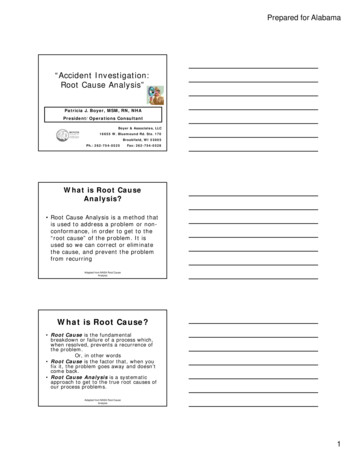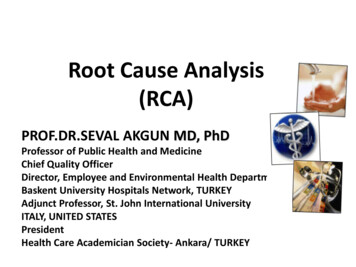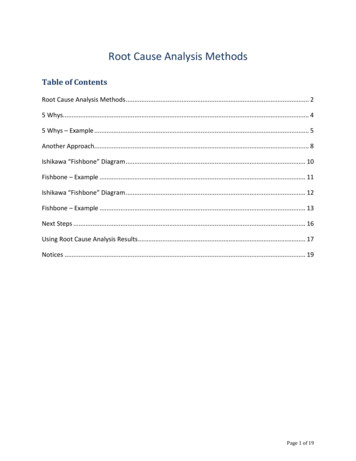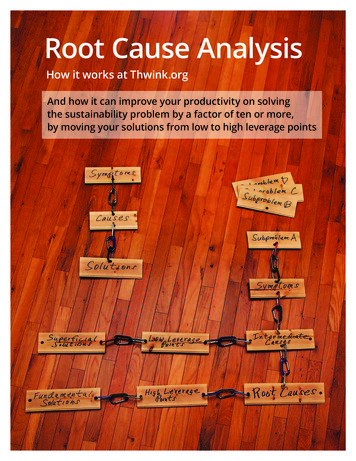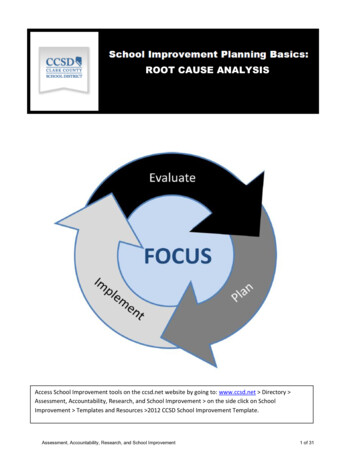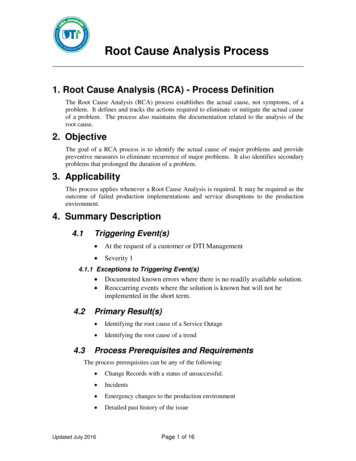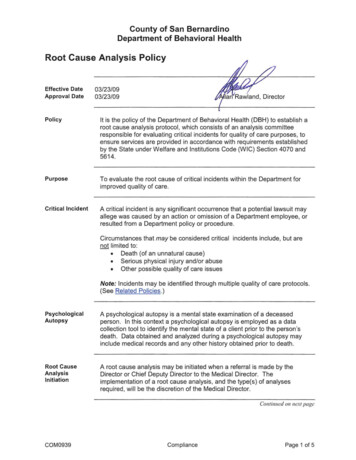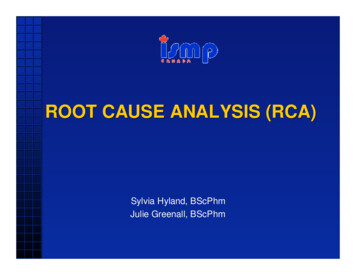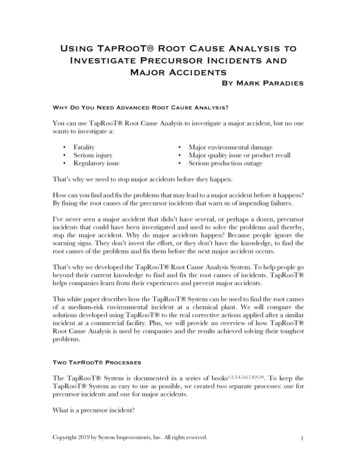
Transcription
Using TapRooT Root Cause Analysis toInvestigate Precursor Incidents andMajor AccidentsBy Mark ParadiesWhy Do You Need Advanced Root Cause Analysis?You can use TapRooT Root Cause Analysis to investigate a major accident, but no onewants to investigate a: FatalitySerious injuryRegulatory issue Major environmental damageMajor quality issue or product recallSerious production outageThat’s why we need to stop major accidents before they happen.How can you find and fix the problems that may lead to a major accident before it happens?By fixing the root causes of the precursor incidents that warn us of impending failures.I’ve never seen a major accident that didn’t have several, or perhaps a dozen, precursorincidents that could have been investigated and used to solve the problems and thereby,stop the major accident. Why do major accidents happen? Because people ignore thewarning signs. They don’t invest the effort, or they don’t have the knowledge, to find theroot causes of the problems and fix them before the next major accident occurs.That’s why we developed the TapRooT Root Cause Analysis System. To help people gobeyond their current knowledge to find and fix the root causes of incidents. TapRooT helps companies learn from their experiences and prevent major accidents.This white paper describes how the TapRooT System can be used to find the root causesof a medium-risk environmental incident at a chemical plant. We will compare thesolutions developed using TapRooT to the real corrective actions applied after a similarincident at a commercial facility. Plus, we will provide an overview of how TapRooT Root Cause Analysis is used by companies and the results achieved solving their toughestproblems.Two TapRooT ProcessesThe TapRooT System is documented in a series of books1,2,3,4,5,6,7,8,9,10. To keep theTapRooT System as easy to use as possible, we created two separate processes: one forprecursor incidents and one for major accidents.What is a precursor incident?Copyright 2019 by System Improvements, Inc. All rights reserved.1
Precursor IncidentMinor incidents that could have been a major accidentif one or two more Safeguards would have failed.The simple process was designed to make root cause analysis as easy as possible (less timeconsuming) while still guiding investigators to the real root causes and helping them developeffective corrective actions.The process for investigating these low-to-medium risk precursor incidents is shown below.The process starts by applying the SnapCharT Diagram (example shown later) todiscover what happened. When you understand what happened, you are ready to decideif there is something important to learn. If not, you stop the investigation. Stopping theinvestigation once you understand the incident isn’t worth investigating can save time andavoid the wasted effort of implementing unnecessary corrective actions.Copyright 2019 by System Improvements, Inc. All rights reserved.2
If a precursor incident is worth investigating, the next step is to identify the incident’sCausal Factors. A Causal Factor is:Causal FactorA mistake, error, or failure that, if corrected,would have prevented the incident or mitigated its consequences.An incident may have several Causal Factors. Each Causal Factor needs to be analyzed tofind its root cause(s). Identifying the Causal Factor’s root causes is the next step.The Root Cause Tree Diagram is used to guide investigators to root causes. The processis explained later in this white paper.Finally, the Corrective Action Helper Guide/Module is used to help investigators developeffective fixes (corrective actions) for the root causes.That’s the simple TapRooT Process.The TapRooT 7-Step Major Investigation Process is shown below Copyright 2019 by System Improvements, Inc. All rights reserved.3
What is the difference between the simple investigation process and the major investigationprocess?1. More steps. The major investigation starts with planning and also looks forGeneric Causes.2. Optional techniques. The major investigation process includes the Equifactor ,CHAP, and Change Analysis techniques to help in the evidence collection phase ofthe investigation.3. No option to stop. In the simple investigation, we can stop if there isn’t anythingimportant to learn. But for a major accident, you need to complete the investigation.Stopping isn’t an option.For more about the TapRooT 7-Step Major Investigation Process and investigatingmajor accidents, read: Using TapRooT Root Cause Analysis for Major Investigations.4Precursor Incident Investigation Using the TapRooT SystemThe following is an example of the use of the TapRooT System to analyze a mediumrisk, environmental incident (Fish Kill) at a chemical plant. The incident has been deidentified and is not intended to represent an actual event at any particular location.This investigation was performed using the simple (low-to-medium risk) investigationprocess shown on page 2.To shorten this example, the information collection portion of the investigation is notshown. Rather, use of the TapRooT System is only demonstrated for the evidenceorganization (what happened), root cause analysis (why it happened), and the developmentof corrective actions (how to improve performance). The three main tools in this exampleare the: SnapCharT DiagramRoot Cause Tree DiagramCorrective Action Helper ModuleInitial Incident DescriptionDuring a normal night shift at a process plant, fish were killed when a temporary watertreatment unit overheated and released hot, low pH water to one of the plant's outfalls. Aninvestigation that included a contractor representative (contract personnel were operatingthe rental temporary water treatment unit) was conducted using the TapRooT System.The preliminary sequence of events is shown on a SnapCharT Diagram on the next page.Copyright 2019 by System Improvements, Inc. All rights reserved.4
Results of Additional InvestigationAfter: Interviews with all contract operators and their supervisors,Discussions with the temporary water treatment unit vendor's engineers,Interviews with plant personnel at the process plant unit,Interviews with procurement personnel, andInterviews with operations management,a more detailed SnapCharT with Causal Factors (indicated by black triangles) wasdeveloped and is shown below and on the next two pages Copyright 2019 by System Improvements, Inc. All rights reserved.5
Continued on next page Copyright 2019 by System Improvements, Inc. All rights reserved.6
The four Causal Factors are marked with a triangle and include all the attachedinformation. Each of the Causal Factors were analyzed for root causes using the RootCause Tree Diagram and Root Cause Tree Dictionary. The following is an analysis ofthe Causal Factor: “Operator did not fix cause of high temperature.”Analyzing a Causal FactorIn an actual investigation, all the Causal Factors would be analyzed to find their root causes.However, to keep this white paper short, we will only explain the analysis of a single CausalFactor – “Operator did not fix cause of high temperature.”The investigator starts at the top of the Root Cause Tree Diagram (shown below, thecomplete Root Cause Tree Diagram is available in Using the Essential TapRooT Techniques to Investigate Low-to-Medium Risk Incidents3) and works down the tree using aprocess of selection and elimination. The investigator thus asks and answers questions toidentify the specific root causes for this Causal Factor.Operator did not fix cause of high temperatureIn this case, the Causal Factor “Operator did not fix cause of high temperature” wasidentified as a Human Performance Difficulty (one of the four major problem categories atthe top of the Root Cause Tree ) and the other three difficulty categories were eliminated.Copyright 2019 by System Improvements, Inc. All rights reserved.7
When the Human Performance Difficulty was identified, the Tree guided the investigatorto a set of 15 questions called the Human Performance Troubleshooting Guide (part of theTree's embedded intelligence). The first of the 15 questions of the guide is shown below.The 15 questions guide the investigator to select which of the seven human performancerelated Basic Cause Categories to investigate further. The seven categories are: ProceduresCommunicationsWork Direction TrainingManagement System Quality ControlHuman EngineeringEach category indicated by a "Yes" answer to the questions in the Human PerformanceTroubleshooting Guide was investigated further to see if it could be eliminated or if one ormore Near-Root Causes and related Root Causes contributed to the problem (and thereby"caused" the incident). The Human Engineering Basic Cause Category is shown below.Copyright 2019 by System Improvements, Inc. All rights reserved.8
For the “Operator did not fix cause of high temperature” Causal Factor, four of the 15questions were answered "Yes." The 15 questions guided the investigator to review thefollowing Basic Cause Categories: Human EngineeringManagement System Work DirectionProceduresA screen shot (from the TapRooT VI Software) of one of these categories (HumanEngineering) with the analysis completed is shown below.When the analysis of all the Basic Cause Categories (not shown here - Work Direction,Procedures, Management System) for this Causal Factor were completed, the followingroot causes were identified:1.2.3.4.Monitoring alertness needs improvement.Shift scheduling needs improvement.Selection of fatigued worker.The "no sleeping on the job" policy needs to have a practical way to make it so thatpeople can comply with it.That’s four root causes (or ways to improve performance) for this Causal Factor.Developing Corrective ActionsOnce the root causes for all of the Causal Factors are analyzed, the investigator uses theCorrective Action Helper Module of the TapRooT Software to help develop thecorrective actions for the root causes. The Corrective Action Helper Module helpsinvestigators:Copyright 2019 by System Improvements, Inc. All rights reserved.9
1. Verify that they are addressing the real causes of the incident.2. Develop corrective actions to fix the specific cause of the problem by applying bestpractices and missing knowledge.3. Develop corrective actions for the generic (or systemic) causes (if applicable) for theproblem.4. Develop additional implementing actions needed to make the corrective actionssuccessful.5. Find references to study the problem in detail and learn more about potentialstrategies to eliminate the problem.The following is an example of the guidance provided by the Corrective Action Helper module of the TapRooT Software for the root cause “Monitoring Alertness NeedsImprovement” that was identified for a Causal Factor of the Fish Kill Incident:Check:You have decided that the problem was related to loss of performance over time whilemonitoring. (The job was too boring.)Ideas:1.You should consider recommending the following options: (Order does not indicatepreference.)a.Provide an alarm to alert the worker and relieve the boredom of monitoring.b.Provide an automated monitoring and response system to replace human monitoringand response. NOTE: this will probably leave the worker in supervisory control. Youwill need to consider ways to keep the worker informed as to what the automation isdoing and to clearly indicate why it is doing it. You should also consider ways to keepthe workers involved in the process so that they maintain their situational awarenessand maintain their manual control proficiency.c.Rotate the person monitoring more frequently. (Experiment to find out how long theycan monitor reliably and then rotate people so that they only monitor for less than thattime.)d.Redesign the job to provide other tasks that don't compete with the monitoring task tokeep the person alert and involved. (For example, playing the radio while driving.) Donot provide tasks that compete for the same resource. (For example, reading a bookwhile driving.)e.Provide false signals to keep the worker involved. However, you should also considerthat people may ignore real signals if they become accustomed to receiving only falsesignals.f.Consult the workers to see if they have ideas that would make the task more interestingwithout conflicting with the monitoring requirements.Copyright 2019 by System Improvements, Inc. All rights reserved.10
2.Fatigue can also combine with monitoring alertness problems. Consider trainingsupervisors to understand that fatigued personnel should not be assigned to tasks thatrequire a high degree of monitoring alertness.3.Also, consider testing individuals for their alertness before assigning them to a monitoringtask.4.Once changes have been approved, consider training the workers about the changes andtheir intended impact.Ideas for Generic Problems:1.If monitoring alertness is a generic problem, consider recommending a review of the jobsto redesign them and add more active tasks.References:For more information about vigilance and monitoring alertness, consider reading:The Psychology of Vigilance by D. R. Davies and R. Parasuraman, 1981. Published by AcademicPress, New York.Engineering Psychology & Human Performance by C. D. Wickens, 1992. Published by Harper-Collins,New York.Again, the Causal Factors were:1.2.3.4.Flexible hose rupturesOperator did not fix cause of high temperatureAutomatic shut-off does not shut down unitOperator did not shut down unit after the alarmAfter reading all the Corrective Action Helper Modules for all the root causes that werediscovered and after considering the seriousness of each, the potential for future problems,and the systemic (generic) nature of each cause, the following corrective actions for allCausal Factors/root causes were developed.1. Replace the old, flexible hose with a new, tested hose. (Causal Factor 1)2. Develop policy on testing and use of equipment in temporary situations.(Causal Factor 1)3. Remove the jumpers and place the automatic trip feature back in service.(Causal Factors 2, 3, and 4)4. Update automatic trip feature with new module to prevent spurious failures.(Causal Factors 3 & 4)5. Negotiate contract revision so that contractor must notify and get approvalfrom the facility prior to disabling any alarm or automatic safety feature.(Causal Factor 3)6. Move diesel driven compressor away from temporary water treatment unitso that the alarm on the unit can be heard. (Causal Factors 2 and 4)Copyright 2019 by System Improvements, Inc. All rights reserved.11
Note that all the Causal Factors are addressed.The corrective actions were reviewed to ensure they were SMARTER. The SMARTERreview is part of the development of corrective actions in the TapRooT System. Whendeveloping corrective actions, they should be:Specific – Specifically, what must be done?Measurable – Can we measure that it was effective?Accountable – Who does it?Reasonable – Is it worth doing?Timely – Will it be accomplished soon enough for the risk involved?Effective – Will it solve the problem?Reviewed – Does it have unintended consequences?As time passes and data is accumulated, the root cause data should be reviewed usingPareto Charts to detect potential areas for generic improvements. Also, data could bereviewed using Process Behavior Charts (either rate charts or interval charts, depending onthe trends to be observed) to detect negative trends or verify that improvement hasoccurred. More information about these advanced trending techniques, see: TapRooT Performance Measures and Trending for Safety, Quality, and Business Management.8Comparison of ResultsA real incident similar to the Fish Kill incident was reported in an industry trade magazine.A 5-Why analysis had been performed. It found that the root cause was the sleepingoperator. The magazine reported the operator had been fired because they had violatedthe company's no sleeping policy. Compare the "fire the operator" corrective action withthe corrective actions presented using the TapRooT System.Corrective Action ComparisonReal IncidentTapRooT Analysis1. Fire the operator.1. Replace the old, flexible hose with a new, tested hose.2. Develop policy on testing and use of equipment intemporary situations.3. Remove the jumpers and place the automatic trip featureback in service.4. Update automatic trip feature with new module toprevent spurious failures.5. Negotiate contract revision so that contractor must notifyand get approval from the facility prior to disabling anyalarm or automatic safety feature.6. Move diesel driven compressor away from temporarywater treatment unit so that the alarm on the unit can beheard.Copyright 2019 by System Improvements, Inc. All rights reserved.12
The real incident corrective action of firing the operator:1.2.3.4.Is easy.Provides an example to others that they need to be alert.Is consistent with the company policy.Seems effective in that no other operators are found sleeping for several weeks afterthe contract operator is fired.However, what factors were missed and left uncorrected and what problems were createdby the “fire the operator” corrective action?1. No actions were taken to improve the equipment reliability (either the reliability ofthe fire hose or of the automatic shutoff and alarm).2. No effective corrective actions were taken to improve monitoring alertness. At best,only a temporary improvement in alertness was achieved. In fact, the results of spotaudits could be nonrepresentative because operators may be "covering" for eachother to ensure that no one else gets fired. The moving of the diesel (so that theoperator hears the alarm) and the fixing of the auto shutoff feature makes thesleeping problem moot. Neither of these were addressed by the “fire the contractoperator” corrective action.3. After a contract operator is fired, other operators will view future investigations withsuspicion and will be less likely to be fully cooperative. For example, would anoperator admit that they had nodded off? Would another operator "tell" on a fellowoperator if he or she found the other operator sleeping? Or would they just "handleit on-shift" and not tell anyone? Would covering up mistakes get in the way ofeffective learning from mistakes?Even though: advanced root cause analysis and developing corrective actions is more difficultthan blaming those involved, andthe TapRooT Investigation suggests more thorough and potentially more difficultto implement corrective actions than the "fire the operator" answer,if the problem really needs to be solved (to improve industrial or process safety, quality, orproductivity), then advanced root cause analysis and implementing effective correctiveactions is worthwhile.Will TapRooT Work for Your Incidents and Accidents?The TapRooT System was developed to help investigators find root causes of safety,process safety, and quality issues. It was not developed from a fault tree nor is it used like achecklist. Instead, the TapRooT System combines both inductive and deductivetechniques with embedded intelligence to guide a systematic investigation to find thefixable root causes of problems. The system can be used either reactively (as in the exampleprovided in this white paper) to prevent the recurrence of precursor incidents or majorCopyright 2019 by System Improvements, Inc. All rights reserved.13
accidents, or the TapRooT System can be used proactively to find ways to improveperformance before a major accident occurs.The TapRooT System goes beyond the simple techniques of "asking why," cause andeffect, fishbone diagrams, or fault tree diagrams. The TapRooT System has embeddedintelligence to guide investigators to find root causes that they previously didn’t have theknowledge to identify. As Albert Einstein said:"It's impossible to solve significant problemsusing the same level of knowledge that created them."The embedded intelligence allows the TapRooT System to be simple to use by people inthe field for investigation of low-to-medium risk incidents and yet robust enough for eventhe most complex major accident investigations.Unlike other common root cause techniques, the TapRooT System is an investigationsystem. This means the tools and techniques in the TapRooT System are used in allphases of an investigation - from initial planning through the collection of information androot cause analysis to the development of corrective actions and the presentation of aninvestigation to management or other interested parties. The system is supported bypatented TapRooT Software that: makes presenting information easy and logical,provides trendable incident/root cause data, andincludes a corrective action management database.The TapRooT System is used in a wide variety of industries, including: Oil & Gas Mining Pipelines Aerospace Healthcare Pharmaceuticals Food and Beverage Mass Transit Airlines Government Facilities and ContractorsUtilities and Nuclear PowerRefining and ChemicalsTelecommunicationsAluminum and SteelPulp and se industries use the TapRooT System to: Improve industrial/occupational safety,Improve process and nuclear safety,Improve transportation safety,Improve product and service quality,Achieve excellent regulatory performance,Copyright 2019 by System Improvements, Inc. All rights reserved.14
Reduce environmental releases,Reduce human errors, andIncrease service and equipment reliability. A limited survey conducted in 2001 by the Center for Chemical Process Safety11 showedthat more CCPS Members used the TapRooT Root Cause Analysis System to investigateprocess safety incidents than any other technique/process.Over the years, TapRooT Users have submitted many success stories that aredocumented in the Industry section of the TapRooT Website (www.taproot.com).Thus, we believe that the TapRooT System will work for the problems you need to solve.That is why we can offer a money back guarantee for TapRooT Training:GuaranteeAttend the TapRooT Training. Go back to work and use what you havelearned to analyze accidents, incidents, near-misses, equipment failures,operating issues, or quality problems. If you don’t find root causes thatyou previously would have overlooked and if you and your managementdon’t agree that the corrective actions that you recommend are muchmore effective, just return your course materials and we will refund theentire course fee.The guarantee proves how confident we are that TapRooT Root Cause Analysis willwork for your company’s incident investigations and problem solving efforts.The best way to learn more about finding root causes using the TapRooT System is toattend a public or an on-site TapRooT Course. These courses will get you started: 2-Day TapRooT Root Cause Analysis Course for investigating low-to-mediumrisk precursor incidents2-Day Equifactor Troubleshooting and TapRooT Root Cause Analysis Coursefor people interested in finding the root causes of equipment failures.5-Day TapRooT Advanced Root Cause Analysis Team Leader Course for peoplewho may be called upon to investigate major accidents or precursor incidents.There is also an annual Global TapRooT Summit for networking, advanced topics,continuing learning, and refresher training.Don’t allow human errors and equipment failures to repeat. Find and fix the real rootcauses and prevent major accidents by using the TapRooT Root Cause Analysis System.Copyright 2019 by System Improvements, Inc. All rights reserved.15
References1. TapRooT Root Cause Analysis Leadership Lessons by Mark Paradies and Linda Unger.(2017) Published by System Improvements, Inc., Knoxville, Tennessee.2. TapRooT Root Cause Analysis Implementation by Mark Paradies and Linda Unger. (2017)Published by System Improvements, Inc., Knoxville, Tennessee.3. Using the Essential TapRooT Techniques to Investigate Low-to-Medium Risk Incidents by MarkParadies and Linda Unger. (2015) Published by System Improvements, Inc., Knoxville,Tennessee.4. Using TapRooT Root Cause Analysis for Major Investigations by Mark Paradies and LindaUnger. (2016) Published by System Improvements, Inc., Knoxville, Tennessee.5. Using Equifactor Troubleshooting Tools and TapRooT Root Cause Analysis to Improve EquipmentReliability by Ken Reed and Mark Paradies. (2019) Published by System Improvements,Inc., Knoxville, Tennessee.6. TapRooT Root Cause Analysis for Audits and Proactive Performance Improvement by MarkParadies, Linda Unger, and Dave Janney. (2016) Published by System Improvements, Inc.,Knoxville, Tennessee.7. TapRooT Evidence Collection and Interviewing Techniques to Sharpen Investigation Skills by BarbPhillips and Mark Paradies. (2017) Published by System Improvements, Inc., Knoxville,Tennessee.8. TapRooT Performance Measures and Trending for Safety, Quality, and Business Management byMark Paradies. (2018) Published by System Improvements, Inc., Knoxville, Tennessee.9. Improved Patient Safety with TapRooT Root Cause Analysis by Ken Turnbull and MarkParadies. (2018) Published by System Improvements, Inc., Knoxville, Tennessee.10. TapRooT Stopping Human Error by Mark Paradies and Joel Haight. (2019) Published bySystem Improvements, Inc., Knoxville, Tennessee.11. Guidelines for Investigating Chemical Process Incidents, Supplemental CDROM, (SecondEdition). (2003) Published by the Center for Chemical Process Safety, New York.The figures and text in this white paper are used by permission of System Improvements,Inc. and are copyrighted material. Reproduction without permission is prohibited byfederal law.Copyright 2019 by System Improvements, Inc. All rights reserved.16
root causes of the problems and fix them before the next major accident occurs. That's why we developed the TapRooT Root Cause Analysis System. To help people go beyond their current knowledge to find and fix the root causes of incidents. TapRooT helps companies learn from their experiences and prevent major accidents.

